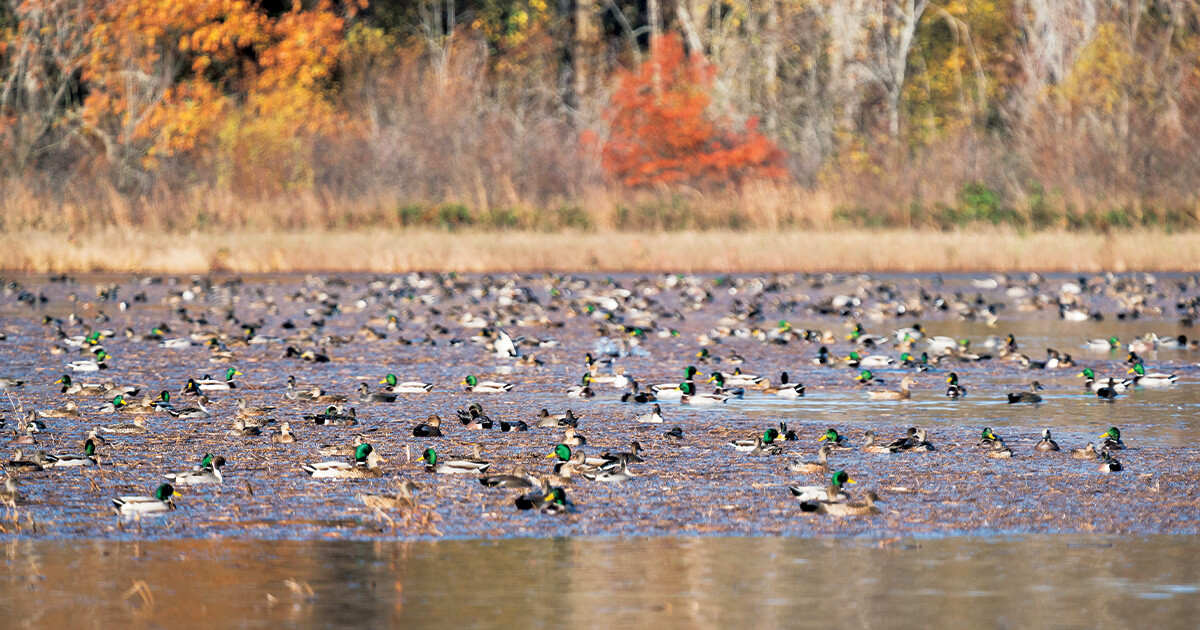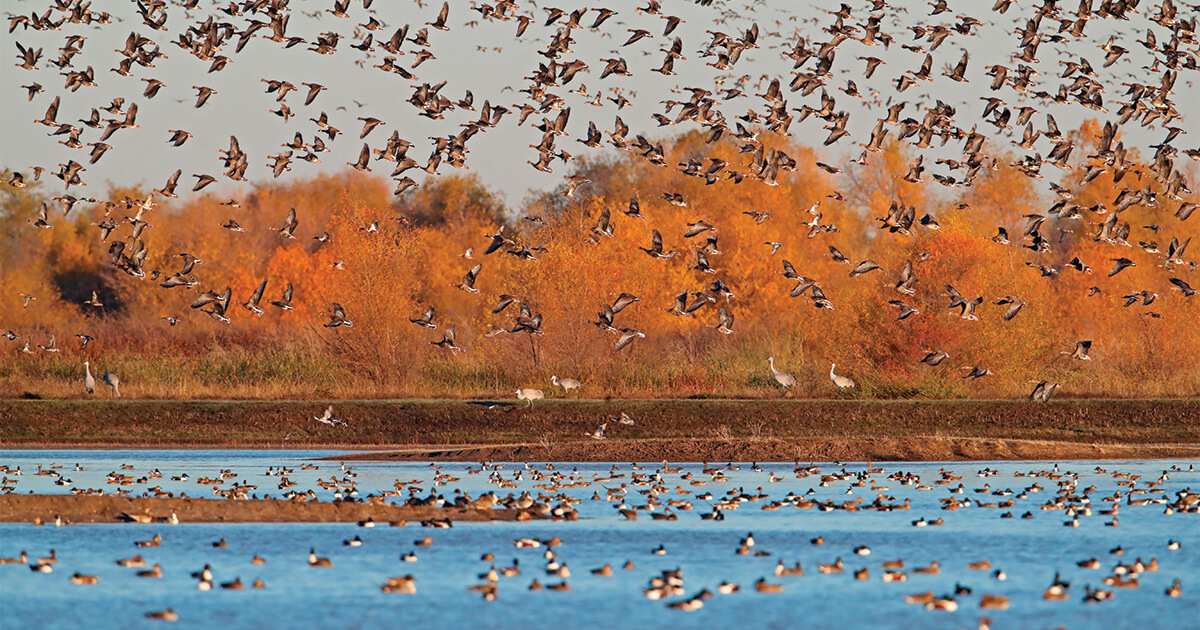Conservation: State Success Stories
Public policy at the state level provides crucial support for DU’s mission
Public policy at the state level provides crucial support for DU’s mission
By Jennifer Boudart

Ducks Unlimited would be hard-pressed to deliver its mission without support from state conservation policies and funding. Many states have one or more conservation funding mechanisms, including royalties, lottery proceeds, appropriations, taxes and fees, and public bond sales. These funding sources help generate millions or even billions of dollars annually for conservation. Following is a quick overview of several recent conservation successes achieved on the state level—some well-established, some brand new—that are helping DU advance its mission.
In Wisconsin, DU State Policy Chair Nels Swenson successfully coordinated a volunteer effort to encourage the state legislature to increase the Wisconsin state waterfowl stamp fee, which hadn’t been adjusted since 1997. The $5 increase will generate nearly $400,000 in proceeds annually. “One hundred percent of the funds raised from the sale of state duck stamps is used to improve the habitat that brings waterfowl to our state, and the additional funds raised will mean that those who enjoy our state’s wetlands will have better and more opportunities to do so,” Swenson says.
State duck stamp sales are a key funding source for the Fall Flights program, which is perhaps the most enduring and farthest-reaching example of state support for DU’s mission. This partnership with the Association of Fish and Wildlife Agencies provides a vehicle for state wildlife agencies to financially support conservation work across Canada, where many of North America’s waterfowl are raised. For its part, DU matches every dollar contributed by state agencies and works with DU Canada to match those dollars with funding from the North American Wetlands Conservation Act (NAWCA) and Canadian partners. Through this process, contributions from state agencies may be multiplied five or six times. More than 40 states now participate in the Fall Flights program, which has contributed more than $88 million and helped conserve over 4.2 million acres of vital waterfowl habitat across Canada.
In the Palmetto State, the South Carolina Conservation Bank helps fund public land acquisitions and bargain-sale conservation easements on private land. DU holds more easements in South Carolina than in any other state, and that is due in large part to its partnership with the Conservation Bank. In total, DU has received more than $13 million in grant funds from the bank, which has funded 19 projects, protecting 21,632 acres in 11 counties. DU and its partners also leverage these funds to secure NAWCA grants, which have been used to conserve an additional 23,000 acres of public land. Champions in the South Carolina General Assembly have been instrumental to the Conservation Bank’s success, most notably Sen. Chip Campsen, who was the first state legislator to receive DU’s national Wetland Conservation Achievement Award. Other key champions in the General Assembly include Sen. Nikki Setzler, Rep. Phillip Lowe, and Speaker of the House Murrell Smith.

In the Central Flyway, the Nebraska Environmental Trust (NET) is funded through proceeds from the state lottery. Since NET was established by the state legislature in 1992, DU has received roughly $6.2 million in grant funding from the trust. These funds have been used directly or leveraged with NAWCA grants to conserve roughly 33,000 acres of crucial migration habitat for ducks, geese, sandhill cranes, endangered whooping cranes, and many other waterbirds, largely in the Rainwater Basin and along the Platte River.
In Mississippi, recent legislative action helped create a much-needed dedicated funding source for conservation. The Mississippi Outdoor Stewardship Trust Fund was established by the state legislature in 2022 with an initial funding level of $10 million. The fund’s purpose is to secure and manage wildlife habitat, provide clean drinking water, improve outdoor recreational areas, and support the conservation of farms and working forests. This landmark legislation followed nearly a decade of hard work by a coalition of partners, including DU. Key legislative champions of the fund include Rep. Bill Kinkade, Rep. Trey Lamar, Sen. Neil Whaley, and Rep. Scott Bounds.
“Securing state-level funding is the most important way to secure federal dollars. Now we can bring more dollars back to the state for waterfowl and hunting opportunities,” says DU Director of Public Policy Ed Penny. DU recently submitted its first grant application and is already working to increase annual funding above $10 million “because demand for projects is so strong, even in its first year.”
In California, bond funds are the primary driver for water-related conservation in the state. One such fund is the Water Quality, Supply, and Infrastructure Improvement Act of 2014 (Proposition 1), which authorized $7.5 billion to support ecosystem and watershed protection and restoration, water supply infrastructure projects, and drinking water protection. Through the Proposition 1 Central Valley Project Improvement Act grant program, DU has received nearly $60 million for wetland conservation projects in the Central Valley. The bulk of that grant money—some $52 million—supported an infrastructure project at Gray Lodge Wildlife Area that will be completed this summer. This project will ensure that, beginning this summer, this popular wildlife area will have the capability to receive its full allocation of water when it’s needed most to meet habitat management objectives.
In addition to funding, public policy can provide an important line of defense for threatened wetlands in many states. In 2022, DU staff and volunteers engaged with the New York State Legislature and Governor Kathy Hochul to deliver important legislative reforms to the New York State Freshwater Wetlands Act. These reforms will allow the Department of Environmental Conservation to protect more than 1 million acres of critically important freshwater wetlands that are currently unmapped and tens of thousands of smaller wetlands of “unusual importance” that provide significant ecosystem services.

For 15 years, the Clean Water, Land, and Legacy Amendment has provided a major source of public funding for conservation in Minnesota. This constitutional amendment added 3/8 of 1 percent to the state sales tax, one-third of which accrues in Minnesota’s Outdoor Heritage Fund (OHF) for grants that support programs to restore, protect, and enhance crucial habitat. Funding from the OHF is annually recommended to the Minnesota Legislature by the Lessard-Sams Outdoor Heritage Council through a competitive grant proposal process. To date, DU has received $98 million in Outdoor Heritage Funds, and an additional $17 million is expected to be awarded this year. OHF grants fund shallow-lake enhancement, wild rice lake protection, wetland restoration, and acquisitions of land for state and federal partners.
Ducks Unlimited uses cookies to enhance your browsing experience, optimize site functionality, analyze traffic, and deliver personalized advertising through third parties. By continuing to use this site, you agree to our use of cookies. View Privacy Policy